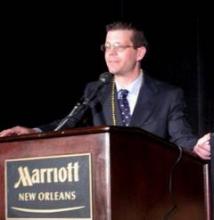NEW ORLEANS – How did dehydration, an order for a peripherally inserted central catheter line, and the bright lights of the ward add up to a full-thickness burn on an infant?
The simple answer is a flashlight.
The more telling response is that the PICC line wasn’t needed in the first place – much less the 20 minutes spent trying to isolate a vein with a flashlight. The infant rebounded with intravenous fluids and by simply advancing feeding volumes, Dr. Alan R. Schroeder said at the Pediatric Hospital Medicine 2013 meeting.
"When we think about patient safety and errors, we spend an awful lot of time talking about how could we better optimize the PICC line process, but we don’t spend as much time on whether this PICC line was even necessary," he said at the meeting, sponsored by the Society of Hospital Medicine, the American Academy of Pediatrics, and the Academic Pediatric Association.
Indeed, physicians are quite good at responding when asked to do more. A recent study of ambulatory health care utilization shows that six of nine quality indicators of underuse improved between 1999 and 2009, whereas only two of eleven overuse indicators got better (JAMA Intern. Med. 2013;173:142-8).
Still, the unnecessary care movement is picking up steam in recent years, insists Dr. Schroeder of the department of pediatrics, Santa Clara Valley Medical Center, San Jose, Calif.
Three medical meetings, including the Preventing Overdiagnosis Conference, were organized this year specifically on medical overutilization, with at least one article devoted each month to the topic in JAMA Internal Medicine.
The Image Wisely initiative has garnered 18,621 pledges to lower the amount of radiation used, while the Choosing Wisely campaign, challenging medical societies to identify five things physicians and patients should question, is bearing fruit.
The pediatric committee of the Society of Hospital Medicine was the first pediatric subspecialty group to respond to the challenge, with a panel of experts, including Schroeder, recently publishing the top five recommendations for pediatric hospital medicine (J. Hosp. Med. 2013 [doi:10.1002/jhm.2064]).
" ‘Less is more’ is almost becoming a trend," Dr. Schroeder said.
Widely publicized public health mistakes in adult medicine, like near-universal prostate-specific antigen testing in men and hormone therapy for menopausal women, coupled with a financially stressed health care system, have helped move the needle. But several barriers to safely doing less still remain, he observed.
Time pressures, malpractice concerns, and pressure from families and colleagues all push physicians to increase healthcare utilization. The case of 12-year-old Rory Staunton, who died last year from potentially preventable septic shock after being released from the emergency department, has prompted new measures nationwide to spot sepsis earlier and a slew of stories in the New York Times and other publications.
The response was quite different, however, when two other adolescents, Jenny Olenick and Ben Ellis, died during or within hours of routine wisdom teeth extraction, a procedure that has been suggested as unnecessary 60% of the time, Dr. Schroeder said.
"They were killed by health care," he said. "This is a commission error, yet this has had scant media coverage. This is the type of case that should really, really upset you."
He went on to say that the omission/commission philosophy has its roots in medical education school.
"A lot of you are doing noble jobs trying to change that, but traditionally we are taught from day one not to miss a diagnosis," he said. "You have to generate these very, very broad differential diagnoses. We don’t want to be the guy that misses a diagnosis on day one and someone else comes in and makes a diagnosis on day two."
Money as motive
Another powerful barrier to safely doing less is the financial motive. Some of the best work in this area was the 2009 watershed essay by surgeon Atul Gawande showing that the strong entrepreneurial spirit in McAllen, Texas, doubled Medicare spending, compared with nearby El Paso, without improving outcomes, Dr. Schroeder observed. Recent research also refuted the widely endorsed belief that PSA screening improves outcomes by picking up more cancers than diagnosing based on symptoms. It was a hard-fought battle with high financial stakes, with some 30 million men undergoing PSA testing each year at a cost of $3 billion.
"There’s not a billboard outside my hospital saying ‘Come see Dr. Schroeder because today he will do less for you,’ " he said. "I wish there were one, but it’s not going to bring patients in or help the hospital’s bottom line."


